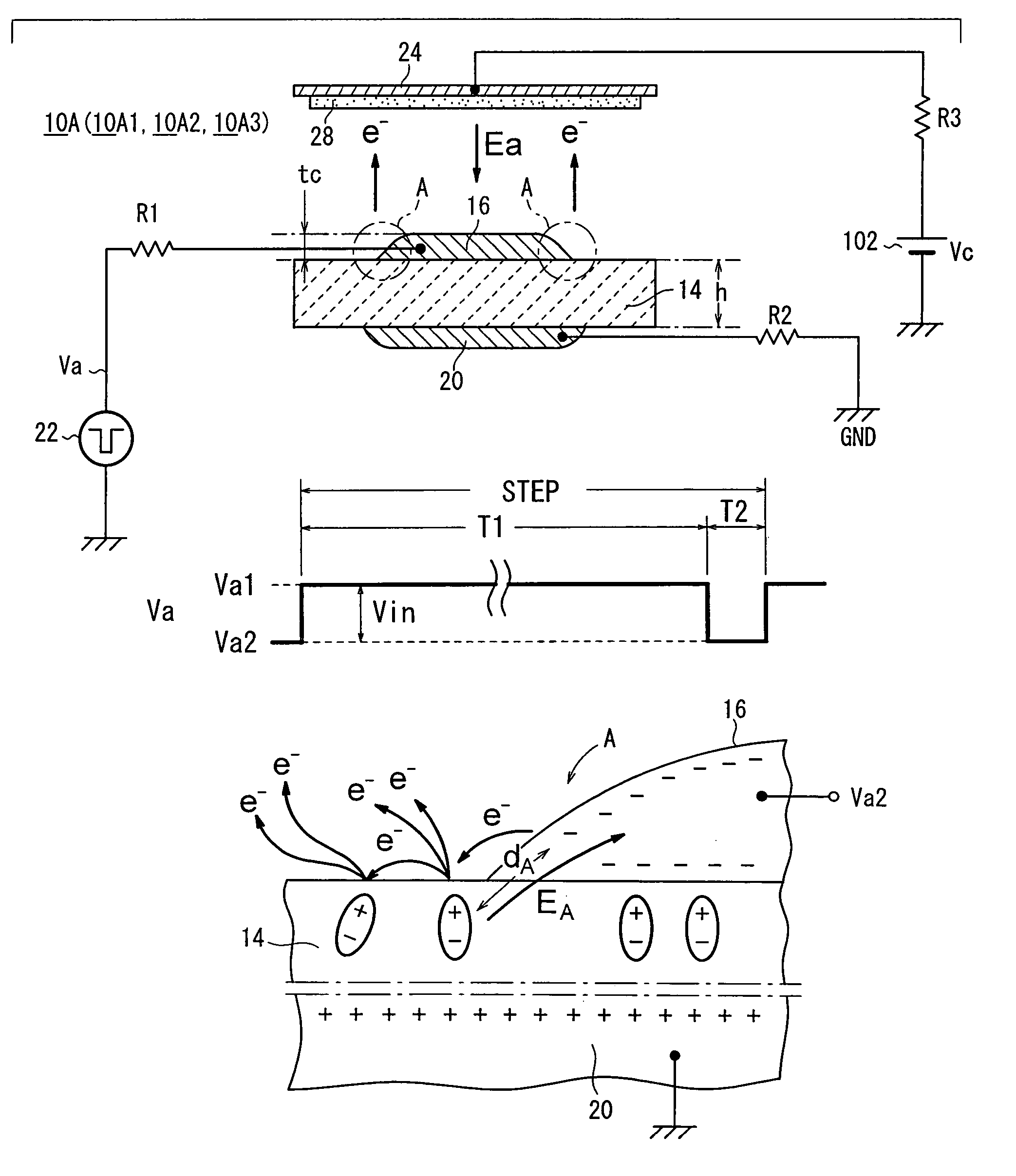Electronic pulse generation device
a generation device and pulse technology, applied in pulse train generators, tubes with screens, instruments, etc., can solve the problems of merely tens of thousands of electrons, complex panel fabrication process, and high panel fabrication cost, and achieve easy control of the number of electrons emitted.
- Summary
- Abstract
- Description
- Claims
- Application Information
AI Technical Summary
Benefits of technology
Problems solved by technology
Method used
Image
Examples
first embodiment
[0066]As shown in FIG. 1, an electronic pulse generation device 10A according to the present invention has an emitter section (emitter element) 14 having a plate shape, a first electrode (a cathode electrode) 16 formed on a front surface of the emitter section 14, a second electrode (an anode electrode) 20 formed on a back surface of the emitter section 14, and a pulse generation source (means for applying alternating pulse) 22 which applies a drive voltage Va between the cathode electrode 16 and the anode electrode 20 through a resistor R1.
[0067]In an example shown in FIG. 1, the anode electrode 20 is connected to GND (ground) and hence set to a zero potential. However, the anode electrode 20 may be set to a potential other than the zero potential. As shown in FIG. 2, the drive voltage Va is applied between the cathode electrode 16 and the anode electrode 20 through a lead electrode 17 extending from the cathode electrode 16 and a lead electrode 21 extending from the anode electrod...
second embodiment
[0160]Next, an electronic pulse generation device 10B will be described with reference to FIG. 19.
[0161]As shown in FIG. 19, the electronic pulse generation device 10B according to the second embodiment has substantially the same structure as the electronic pulse generation device 10A according to the first embodiment, but differs from the electronic pulse generation device 10A in that the electronic pulse generation device 10B includes one substrate 12, an anode electrode 20 is formed on the substrate 12, the emitter section 14 is formed on the substrate 12 to cover the anode electrode 20, and the cathode electrode 16 is formed on the emitter section 14.
[0162]As with the electronic pulse generation device 10A according to the first embodiment, the electronic pulse generation device 10B can prevent the damages of the cathode electrode 16 by the positive ions, and has a long service life.
[0163]The emitter section 14 may be formed on the substrate 12 by any of various thick-film form...
third embodiment
[0175]Next, an electronic pulse generation device 10C will be described with reference to FIGS. 20 through 24B.
[0176]The electronic pulse generation device 10B according to the second embodiment has substantially the same structure as the electronic pulse generation device 10A according to the first embodiment described above, but differs from the electronic pulse generation device 10A in that both the cathode electrode 16 and the anode electrode 20 are disposed on one surface of the emitter section 14, with a slit 18 defined between the cathode electrode 16 and the anode electrode 20, the emitter section 14 being partly exposed through said slit 18.
[0177]As shown in FIG. 20, the electronic pulse generation device 10C has electric field concentration points A, B. The point A can also be defined as a triple point where the cathode electrode 16, the emitter section 14, and a vacuum are present at one point. The point B can also be defined as a triple point where the anode electrode 2...
PUM
 Login to View More
Login to View More Abstract
Description
Claims
Application Information
 Login to View More
Login to View More - R&D
- Intellectual Property
- Life Sciences
- Materials
- Tech Scout
- Unparalleled Data Quality
- Higher Quality Content
- 60% Fewer Hallucinations
Browse by: Latest US Patents, China's latest patents, Technical Efficacy Thesaurus, Application Domain, Technology Topic, Popular Technical Reports.
© 2025 PatSnap. All rights reserved.Legal|Privacy policy|Modern Slavery Act Transparency Statement|Sitemap|About US| Contact US: help@patsnap.com



